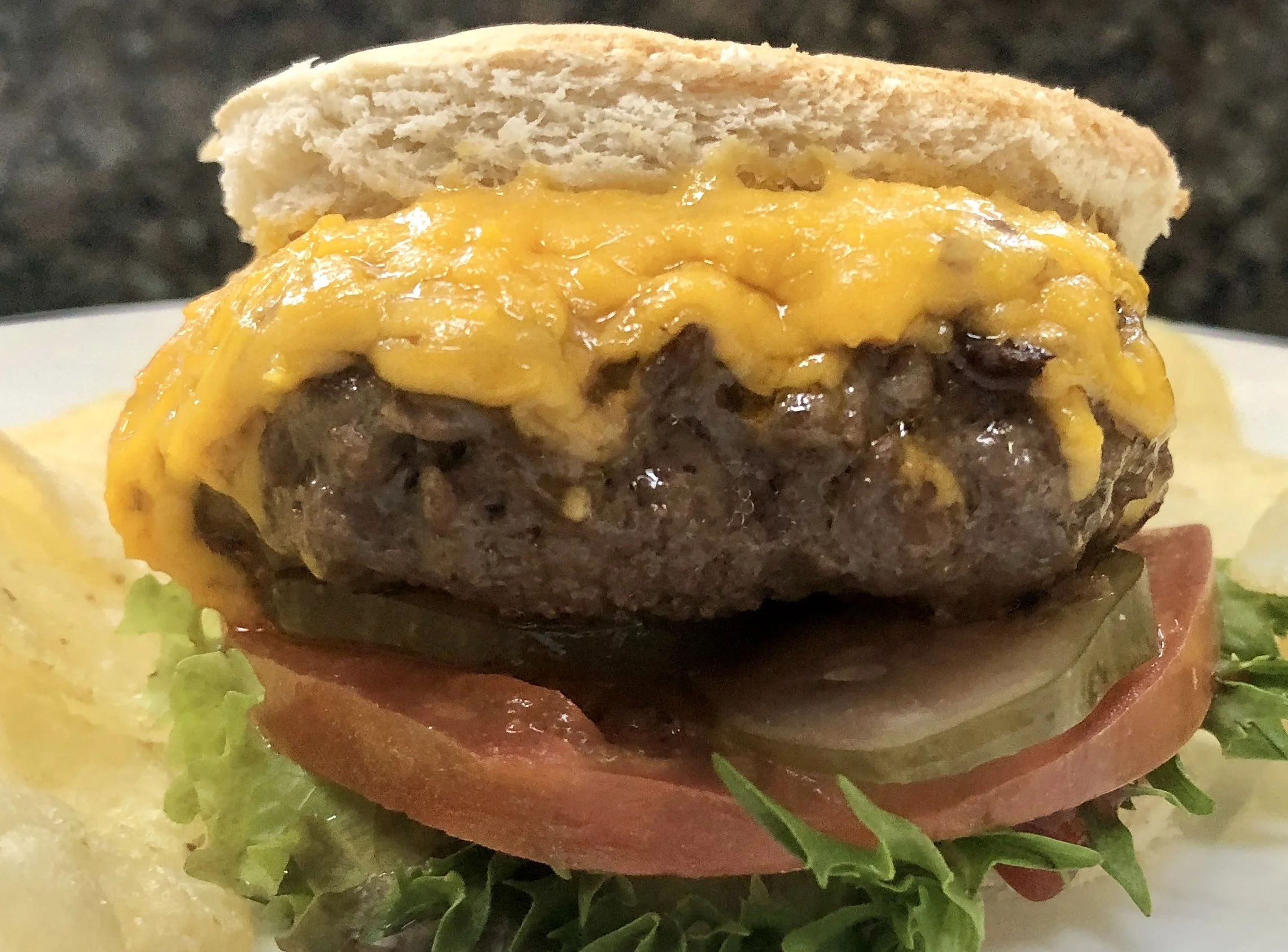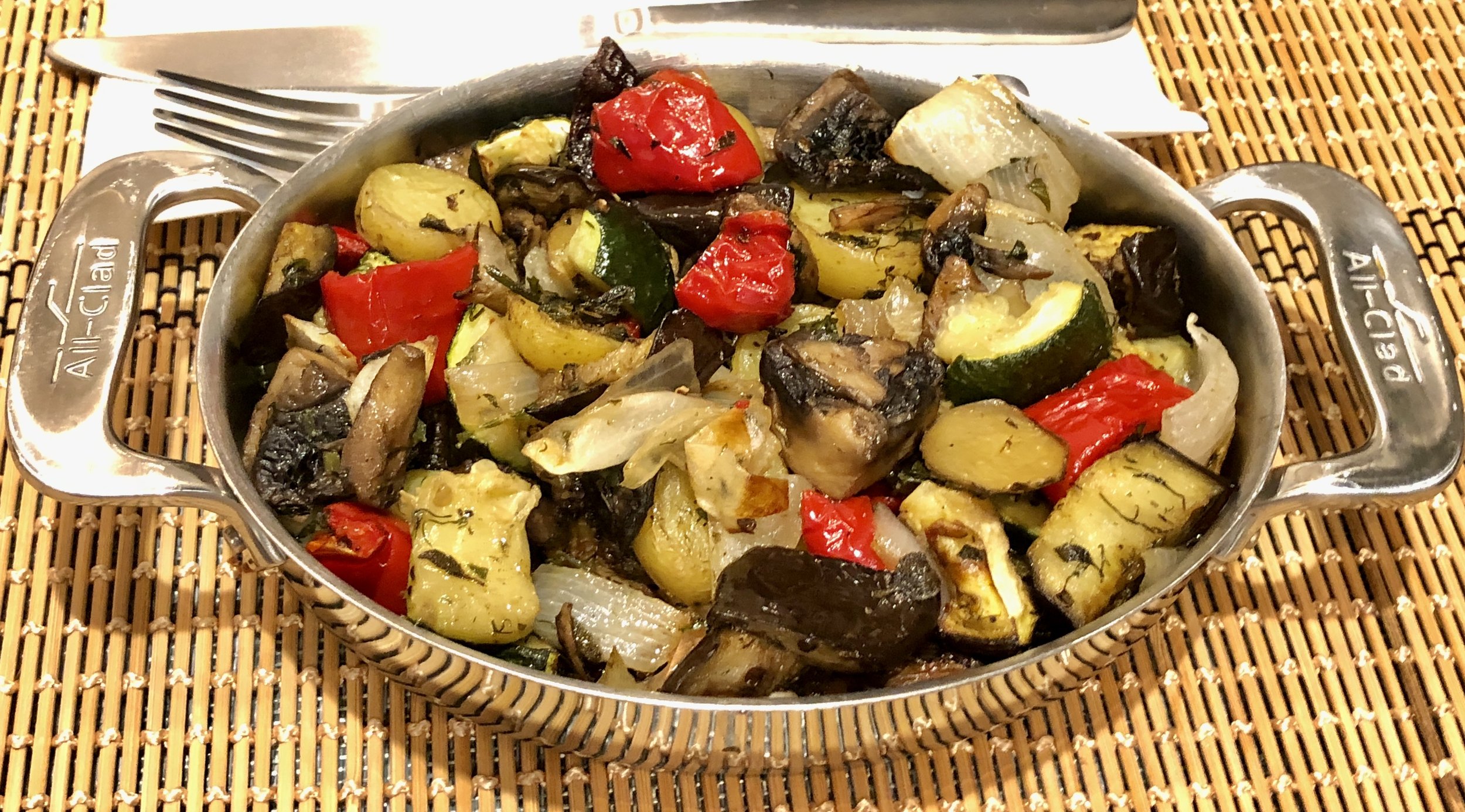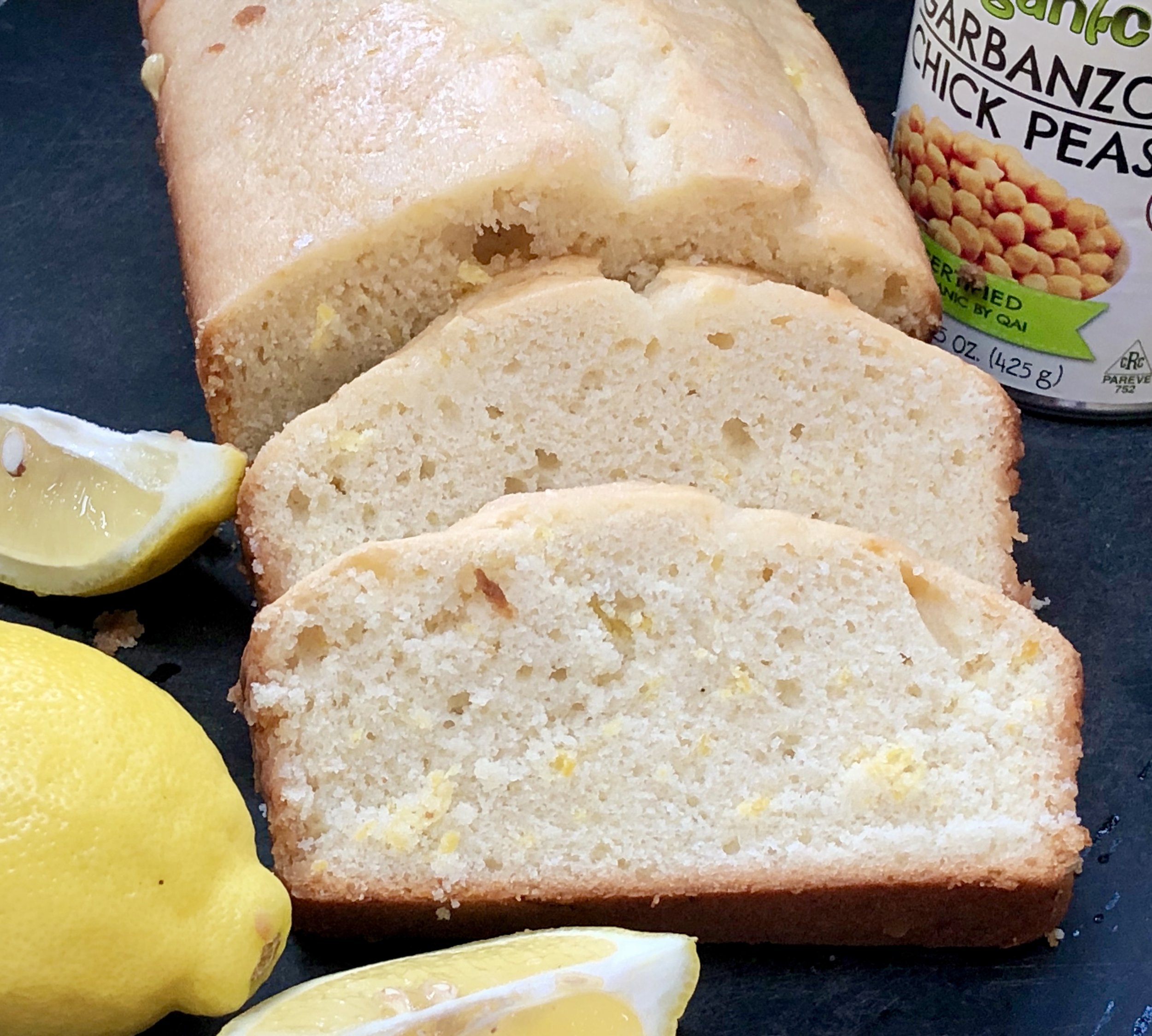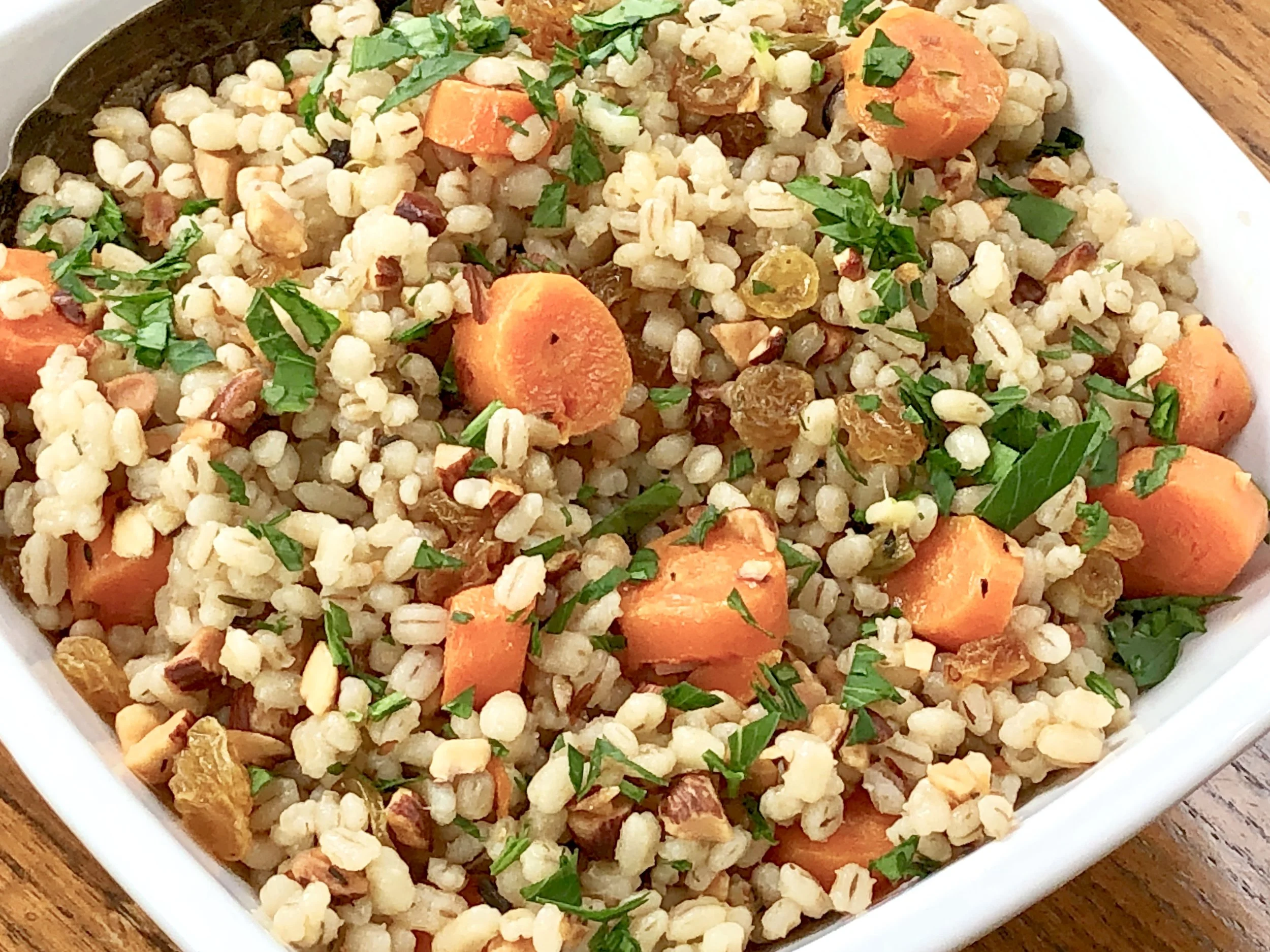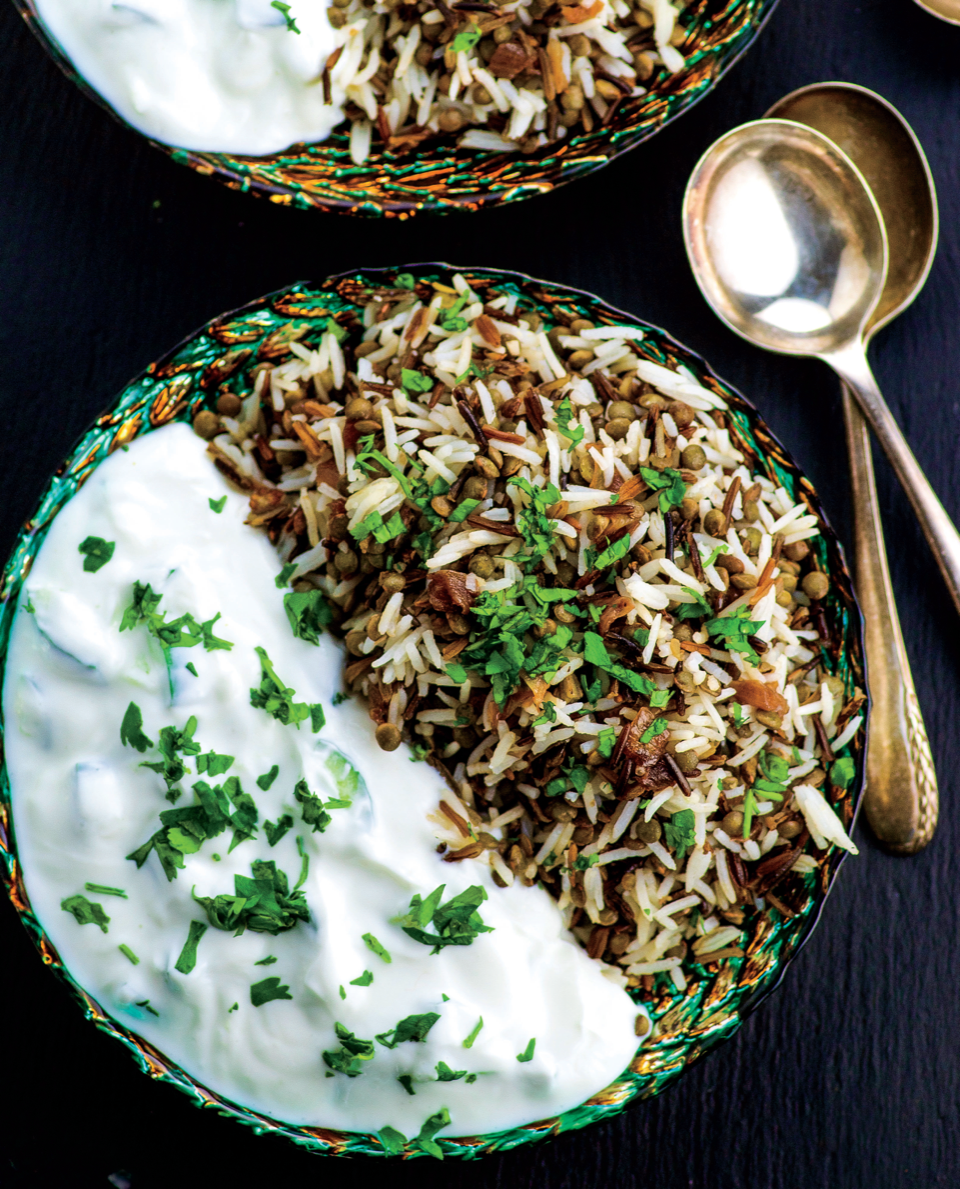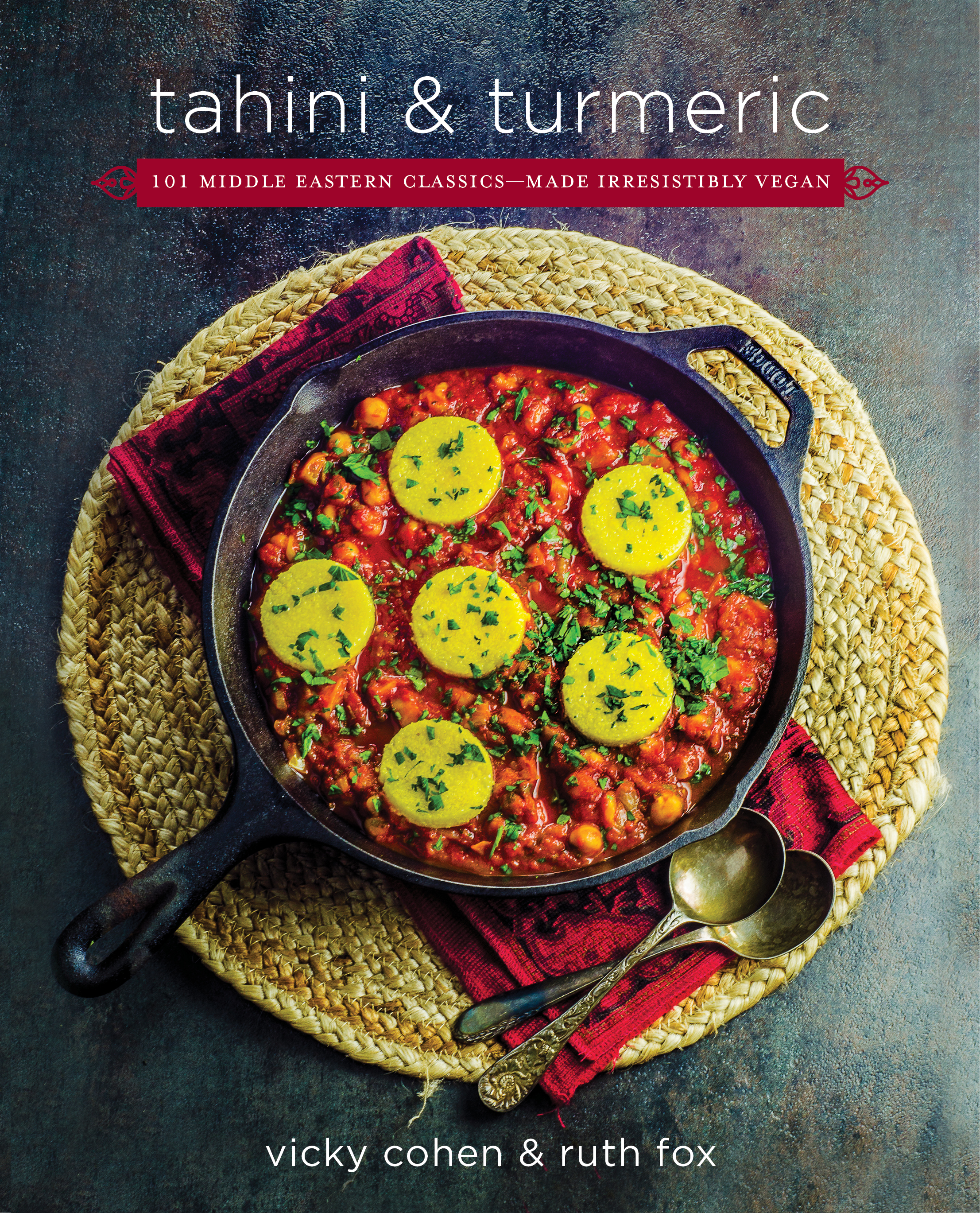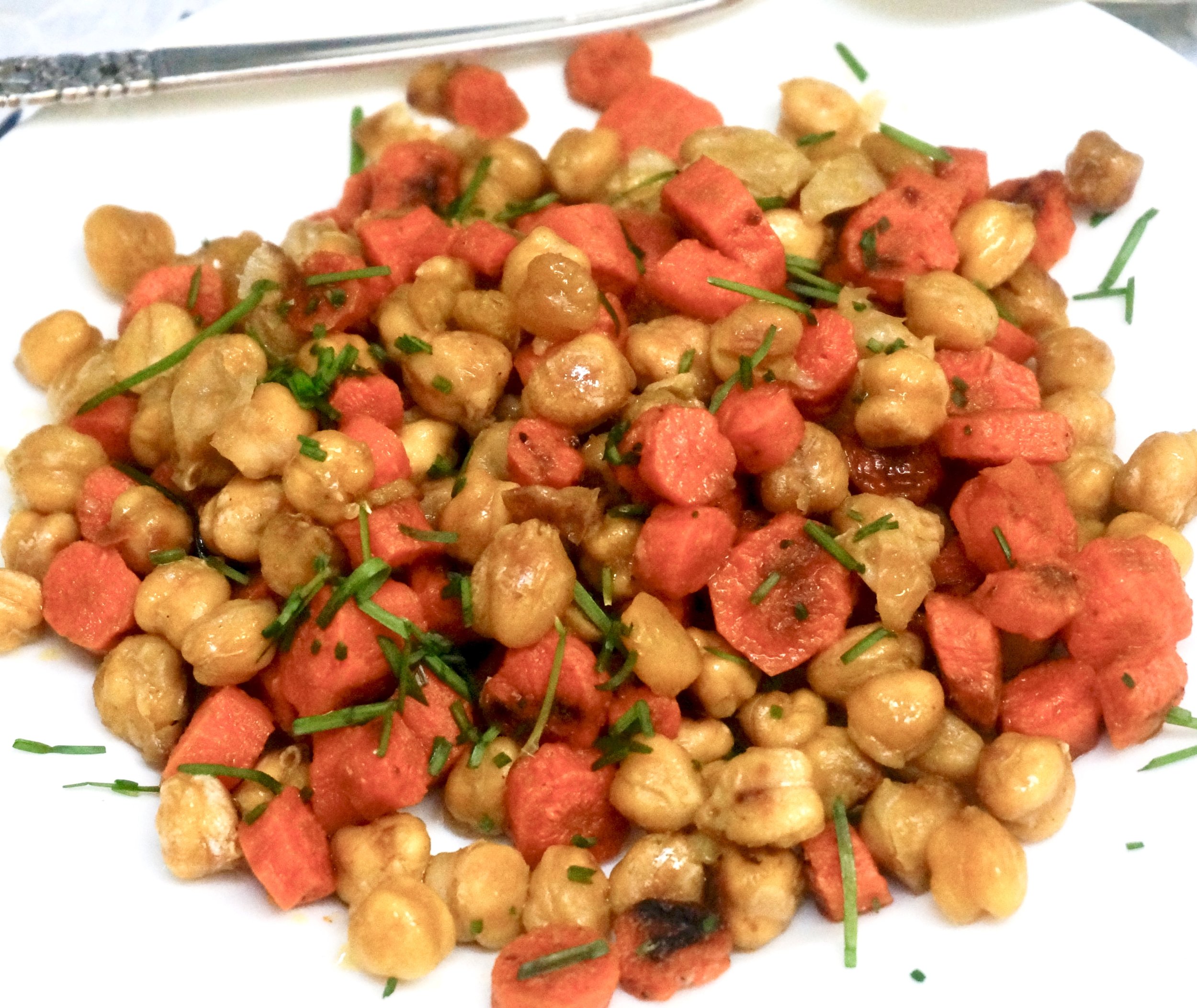Hamburger with vegan Never Better Foods “cheddar" cheese”
Roasted Vegetables
I make roasted vegetables all the time, with different combinations of veggies and seasonings. It’s such a useful dish. A good side dish for sure, but also:
nice over polenta/mamaliga for a substantial vegetarian dinner
cooked, then covered with shredded mozzarella cheese and baked until the cheese bubbles and melts
placed on a pizza crust and topped with cheese (as above)
topped with a fried egg
served at room temperature as a salad (drizzled with olive oil and wine vinegar or Balsamic vinegar)
and so on ….
Roasted Vegetables
12-16 baby potatoes
1 large onion, peeled
1 medium eggplant
1 sweet red bell pepper, deseeded
1 medium zucchini
8 ounces mushrooms
5 tablespoons olive oil
3 cloves garlic, chopped
salt and pepper
3 tablespoons mixed finely chopped fresh parsley and/or herbs such as thyme, basil, marjoram, rosemary, etc.
Balsamic vinegar or lemon juice, optional
Preheat the oven to 400F. Wash and drain the vegetables. Slice the potatoes 1/8-inch thick. Cut the onion, eggplant, red pepper, zucchini and mushrooms into chunks. Place all the vegetables in a single layer inside a large roasting pan. Pour olive oil over vegetables and toss to coat them. Sprinkle with garlic, salt and pepper and herbs. Toss to coat the vegetables evenly. Place the vegetables in the oven. Turn the heat down to 350F and roast the vegetables for about 50 minutes, stirring them occasionally. Serve hot or at room temperature. Serve plain or sprinkled with Balsamic vinegar or lemon juice.
Makes 8 servings
Lemon Aquafaba Bread
At this particular time, when we are going through a world-wide crisis, a terrifying pandemic, it can be therapeutic for many of us to cook and bake.
I am one of those people.
I have plenty of ingredients to cook with because over the years I’ve learned to keep shelf-stable foods on hand in case I can’t shop: ingredients such as canned beans, rice, frozen veggies, dried fruit, canned or packaged milk, and so on.
Equally important for me is — don’t waste food (I’ve talked about that often). I believe that it is important to use all resources — “food forage” as my colleague Susan Barocas calls it. Don’t throw out any ingredient that’s useable, including leftovers.
With all this in mind I offer this lemon bread.
I have lots of lemons in my crisper because of an article I am writing. I’ve developed the recipe for that, so I need to make use of the extra lemons.
I also needed to do something with the liquid leftover from a can of chick peas that I opened for a salad. Chick pea liquid is incredibly useful.
In case you aren’t familiar with this leftover liquid (also from canned beans), it is called aquafaba and it can be used in place of eggs. That makes it an ideal ingredient for vegans and anyone who is allergic to or otherwise can’t eat eggs.
When you beat chick pea liquid with a whisk, it traps air like eggs do, so baked goods have both structure and also a light, tender crumb.
I am trying not to use too many fresh eggs that I might need for meals, so I used the aquafaba instead to make this lemon bread.
Dee-lish!
To get the most out of the liquid in a can of chick peas, be sure to scrape the residue at the bottom of the can. For best results, reduce the liquid slowly over medium-low heat until it becomes the consistency of egg white. Use about 3 tablespoons of the liquid in place of each egg.
For another delicious recipe (carrot bread) using aquafaba, click here.
Lemon Aquafaba Bread
6 tablespoons aquafaba
4 tablespoons coconut oil
3/4 cup sugar
1 tablespoon finely grated fresh lemon peel
2 cups all-purpose flour
2-1/2 teaspoons baking powder
3/4 teaspoon salt
1 cup coconut milk
1/4 cup fresh lemon juice
1-1/2 tablespoons sugar
Preheat the oven to 350 degrees. Grease a 9”x5”x3” loaf pan. If the aquafaba seems thin, boil it for a few minutes to thicken slightly to the consistency of egg white. Set aside to cool. In the bowl of an electric mixer, beat the coconut oil and 3/4 cup sugar at medium speed for 1-2 minutes or until well combined. Add the lemon peel and aquafaba and blend them in. Mix the flour, baking powder and salt in a small bowl. Add the dry ingredients to the creamed mixture in thirds, alternating with the coconut milk. Beat to blend the ingredients to a smooth, even batter. Spoon the batter into the prepared pan. Bake for 50-55 minutes or until a cake tester inserted into the center comes out clean. While the bread is baking, combine the lemon juice and 1-1/2 tablespoons sugar in a small saucepan and cook over medium heat for 1-2 minutes or until the sugar has dissolved. When the bread comes out of the oven, pour the lemon juice mixture on top. Cool the bread in the pan for 10 minutes. Invert onto a cake rack to cool completely.
Makes one bread
Matbucha
Spring has sprung and for me, that means more salad.
So I got to thinking about that word salad, which I realize means so many things that I was never able to fit all of my salad recipes into a file folder simply marked “salad.” I had to sub-categorize them into files such as “grain salads,” “tomato salads,” “fruit salads” and so on.
Over the years I’ve made salads of all sorts. Some based mostly on greens and some that had no greens at all.
I’ve made beet salads, dinner salads, fish salads and quinoa salads.
I could go on. But really, there is no one way to describe “salad,” even though a dictionary might say something like “a mixture of raw and cooked vegetables served with dressing.”
No.
Because recently I prepared some Matbucha, which is an entirely different salad category.
Matbucha is a “salade cuit” — that is, “cooked salad.” In fact the word Matbucha, is an Arabic word that means “cooked salad".”
Cooked salad may seem odd to Western thinking except for the fact that most of us actually eat lots of cooked salads, such as potato salad and egg salad too. We just don’t think of them as “cooked salads,” but that’s what they are.
Matbucha is a Moroccan dish, especially popular in the Moroccan Jewish community, which was once large and thriving in North Africa. When good numbers of Moroccan Jews migrated to Israel, they brought their love of this dish with them and it is now wildly popular in Israel too.
For good reason: Matbucha is vibrantly tasty, easy to cook and is ideal for Shabbat because, even though it’s cooked, you can serve it at room temperature. Use it as a salad course or as a side dish with dinner. I’ve always served it with hors d’oeuvre, as a topping for crackers or pita wedges (it works well with other Middle Eastern nibbles and dips such as hummus, raheb, baba ghanoush and so on).
You can make Matbucha 3-4 days ahead. That’s handy isn’t it?
Matbucha
2 large red bell peppers
3 tablespoons olive oil
1 serrano pepper, deseeded and chopped
2 large cloves garlic, finely chopped
6 medium tomatoes peeled and finely chopped
1-1/2 teaspoons paprika
1 teaspoon sugar
1/2 teaspoon salt or to taste
Preheat the broiler. Place the peppers under the broiler, about 4-6" away from the heat, and broil for 2-3 minutes, until the skin has blistered. Turn the peppers and repeat this process until the entire surface is blistered and lightly charred. Remove the peppers and place them in a paper bag. Let rest at least 10 minutes. Remove the peppers from the bag, peel off the skin and discard the stem and the seeds. Cut the peppers into pieces. Heat the olive oil in a large saucepan over medium heat. Add the peppers, serrano pepper and garlic and cook for 2-3 minutes. Add the tomatoes, paprika, sugar and salt. Bring to a simmer over medium-high heat. Cook for 30-35 minutes, until most of the liquid has evaporated and the mixture is thick.
Makes 1-1/2 to 2 cups
Barley with Carrots, Raisins and Almonds
For me, the appeal of winter foods is their ability make me feel warm and well-nourished. I don’t expect them to be gorgeous. When I look at dishes such as beef stew or a beloved chicken-and-soup, I don’t see art, I see safety and memory and the expectation of comfort.
This is why, when winter comes, I look for side dishes or desserts or an appetizer that can provide some color or add some beauty to the entree or the meal.
This barley casserole fits the bill. It’s a substantial side dish that works with meat, fish and poultry, with stews and hearty winter casseroles and for vegetarian meals too. It’s colorful and makes for an attractive addition to a winter dinner.
Barley with Carrots, Raisins and Almonds
2 tablespoons olive oil
2-3 carrots, sliced 1/2-inch thick
3-4 scallions, chopped
1 cup pearled barley
2-1/2 cups vegetable stock
salt and freshly ground black pepper to taste
1-1/2 teaspoons chopped fresh thyme
1/2 cup golden raisins
1/2 cup chopped toasted almonds
2 tablespoons chopped fresh parsley
Heat the olive oil in a sauté pan over medium heat. Add the carrots and scallions and cook for about 2 minutes. Add the barley and cook for another 2 minutes, stirring often. Pour in the stock and add the salt, pepper and thyme. Stir, bring to a boil, lower the heat, cover the pan and simmer for about 50 minutes or until all the liquid has been absorbed. Stir in the raisins and almonds and toss gently to distribute the ingredients evenly. Cover the pan and let rest for 5 minutes. Spoon into a serving bowl and sprinkle with parsley.
Makes 6-8 servings
Chocolate-Banana-Applesauce Cake
When I was a kid my mother sometimes made macaroni-and-cheese using somewhat older, hard-around-the-edges American cheese that didn’t look fit to eat. I thought it was appalling.
But she told me that these cheese wasn’t spoiled, just hard because maybe it wasn’t wrapped quite so well, and that in any event she would never make any dish for us using an ingredient that could be harmful.
Of course.
And also, why waste perfectly good cheese that’s going to melt anyway. So if it isn’t perfect to eat cold, as is, it is perfectly fine for macaroni and cheese.
And it was. She made delicious macaroni and cheese.
My children are appalled if I use an ingredient that’s past its sell-by/expiration date. I feel the same way my mother did. I would never use an ingredient that is spoiled or harmful. But some of those expiration dates are meant more as a “use them soon because the flavor or texture won’t be perfect” than “do not eat this EVER!”
So recently, I noticed that in addition to some fresh bananas turned black-spotty, my snack packages of applesauce were a month beyond their expiration date. Rather than give the applesauce to my grandkids and have my daughters feel appalled, I used it in chocolate cake, in the place of eggs.
Not only was I able to use up a perfectly good ingredient, the cake was delicious and also a good vegan choice.
So there.
Chocolate-Banana-Applesauce Cake
3 ounces semisweet chocolate
1-1/3 cups all-purpose flour
1/3 cup unsweetened cocoa powder
1 teaspoon baking soda
1 teaspoon salt
2 medium ripe bananas
1 cup sugar
1/2 cup applesauce
1/3 cup apple juice (or orange juice)
1 teaspoon vanilla extract
Preheat the oven to 350 degrees. Lightly grease an 8”x8” cake pan. Melt the chocolate and set it aside to cool. In a bowl, whisk together the flour, cocoa powder, baking soda and salt. Set the flour mixture aside. Mash the bananas and place them in the bowl of an electric mixer (or use a hand mixer and bowl). Add the sugar and mix at medium speed for a minute, or until well blended. Add the applesauce, juice, vanilla extract and melted chocolate and beat for 1-2 minutes, or until thoroughly blended. Add the flour mixture and beat for 1-2 minutes, or until throughly blended. Spoon the batter into the prepared cake pan. Bake for 25-30 minutes or until a cake tester inserted into the center comes out clean.
Makes 9 servings
Tahini Turmeric and Mjadra
I have made mjadra (mujadara) so often I can't even count the ways. It's a family favorite that I serve on special occasions (the #1 item at my Yom Kippur Break-the-Fast), at somber times (the Nine Days), for holidays (my Thanksgiving vegetarian entree) and sometimes just for any old meatless meal.
I've made mujadara using bulgur wheat and brown rice, barley and kaniwa.
But I never made it with wild rice or with white rice. In fact, I hadn't even thought about that possibility until I got Vicky Cohen and Ruth Fox's new cookbook: tahini & turmeric; 101 Middle Eastern Classics Made Irresistibly Vegan.
This is one gorgeous book, stuffed with recipes that anyone who loves good food, or who is kosher or a vegetarian or even a hearty carnivore and even a vegan-skeptic would find -- yes -- irresistible.
There were (still are) so many recipes I want to try. I've followed Vicky and Ruth's blog for years and have cooked many of the dishes in their posts, every one of them a winner.
But when I saw the recipe for Mjadra, I knew that had to be the first from the book.
It was as delicious as any version of this dish I have ever tried. The addition of pomegranate molasses to the onions gave the dish a faint, lush tang. The authors suggest one of two sauces to accompany the grains. I prepared the (vegan) Cucumber Yogurt Sauce (which is also paired in the book with Zucchini Fritters -- a delicious-sounding recipe that I will try next to see how the taste compares with my own, non-vegan version).
Every recipe sounds and looks tempting. Over the summer I will try my hand at the Tangy Roasted Carrot Hummus -- a quick and easy hors d'oeuvre for the company I am sure to have. And because I love all versions of Shakshuka, I will definitely try the interesting Chickpea and Pepper Shashuka -- with rounds of polenta taking the place of the traditional eggs! (It's the recipe on the book cover.) Before the High Holidays I am going to try the spectacular-sounding Creamy Tahini Cheesecake with Pistachio Crust and Fresh Pomegranate.
I could go on and on. I rarely post about cookbooks, but this one is special, and comes in handy particularly this week, when the Nine Days begin and observant Jews will be eating meatless meals.
Good luck with the book Vicky and Ruth!
WILD RICE MJADRA
Our take on this classic Middle Eastern dish incorporates wild rice and sautéed on-ions, as opposed to fried, for a healthier version. We also cook the rice, lentils, and onions separately, and then mix them together right before serving. This is a fool-proof method to prevent the mjadra from becoming mushy.
Traditionally, this dish is served topped with a cucumber yogurt sauce, which we made using nondairy yogurt (see Zucchini Fritters with Cucumber Yogurt Sauce, page 26). While we were growing up, our dad always ate it with his favorite Spicy Israeli Salsa (page 62), made with freshly picked tomatoes and cucumbers from his garden.
Store in the refrigerator for up to four days.
Prep time: 10 minutes
Cook time: 50 minutes
Makes 6 to 8 servings
INGREDIENTS:
WILD RICE:
½ cup uncooked wild rice
½ teaspoon salt
LENTILS:
1 cup dried French green lentils,
picked over and rinsed well
½ teaspoon salt
WHITE RICE:
1 cup uncooked basmati rice
1 teaspoon salt
SAUTÉED ONIONS:
2 tablespoons extra-virgin olive oil
1 large onion, sliced
¼ teaspoon salt
1/8 teaspoon freshly ground black pepper
1 tablespoon pomegranate molasses
(see page 132 for homemade)
Cucumber Yogurt Sauce (page 26) or Spicy Israeli Salsa (page 62), to serve
Prepare the wild rice: Bring 2 cups of water to a boil in a medium-size saucepan over high heat. Add the wild rice and salt. Bring again to a boil, lower the heat to low, and simmer, covered, for 40 to 45 minutes, or until tender. Remove from the heat, drain well, and set aside.
Prepare the lentils: Bring 4 cups of water to a boil in a large saucepan over high heat. Add the lentils and salt. Lower the heat to medium and cook, uncovered, for 18 to 20 minutes, or until the lentils are soft but not mushy. Remove from the heat, drain well, and set aside.
Prepare the basmati rice: In a medium-size saucepan, bring 1½ cups of water to a boil in a separate medium-size saucepan over high heat. Add the basmati rice and salt. Return to a boil, lower the heat to low, and simmer, covered, for 20 minutes, until the water has been absorbed and the rice is tender. Remove from the heat and set aside, covered.
Prepare the onion: Heat the olive oil in a large, nonstick skillet. Add the sliced onion, salt, and pepper, and cook over high heat for 5 minutes, stirring often. Lower the heat to medium-low and cook for 15 minutes. Add the pomegranate molasses and continue to cook for another 5 minutes, or until the onion turns dark golden brown.
Assemble the mjadra: Combine the cooked wild and basmati rice, the cooked lentils, and the onion in a large bowl, and toss well. Serve warm, topped with Cucumber Yogurt Sauce or Spicy Israeli Salsa.
Referenced recipes:
CUCUMBER YOGURT SAUCE:
½ cup plain unsweetened coconut or CASHEW YOGURT
1½ teaspoons freshly squeezed lemon juice
¼ teaspoon salt
1 small cucumber, peeled and cut into small dice
SPICY ISRAELI SALSA:
1 pound assorted colored tomatoes, diced small
5 to 6 Persian cucumbers, diced small
2 to 3 jalapeño peppers, diced small
½ cup chopped fresh cilantro
2 tablespoons extra-virgin olive oil
2 tablespoons freshly squeezed lemon juice
¼ to ½ teaspoon salt
HOMEMADE POMEGRANATE MOLASSES:
6 cups pomegranate juice
1 cup sugar
1/3 cup freshly squeezed lemon juice
Combine all the ingredients in a large saucepan and bring to a boil. Lower the temperature to a low boil and cook, uncovered, for 2 hours, or until the liquid has reduced to about one third. Keep an eye on it, so it doesn’t overflow.
Remove from the heat, let cool, and transfer to a glass jar with a tight lid. The molasses will thicken once cooled.
Store in the refrigerator for up to six months.
Excerpted from Tahini and Turmeric: 101 Middle Eastern Classics—Made Irresistibly Vegan by Ruth Fox and Vicky Cohen. Copyright © 2018. Available from Da Capo Lifelong Books, an imprint of Perseus Books, LLC, a subsidiary of Hachette Book Group, Inc.
Roasted Chick Pea and Carrot Salad
This dish, which I have made many ways, with many variations over the years, is a nice post-Passover treat for those who don't eat chick peas or beans during the holiday.
It's also an easy dish to do and goes with just about everything and anything else you might be serving at any time during the year -- roasted chicken, grilled fish, steak.
It's a colorful, filling dish for a meatless Monday or vegetarian meal.
I'd use it (have used it) for Thanksgiving dinner.
All in all, a pretty useful recipe.
As I said, versatile too: use white beans instead of chick peas, wine vinegar instead of lemon juice. Add some red onion, thawed frozen peas. Like that.
Roasted Chick Pea and Carrot Salad
- 2 cups cooked chick peas
- 1 pound carrots, sliced 1/4-inch thick
- 4 tablespoons olive oil
- salt
- 1/2 teaspoon ground cumin
- 3-4 tablespoons lemon juice
- freshly ground black pepper to taste
- 2-3 tablespoons chopped fresh parsley or chives
Cook dried chickpeas according to package directions (or drain canned chick peas). Preheat the oven to 425 degrees. Place the chick peas and carrots on a baking sheet. Pour 2 tablespoons olive oil over the vegetables. Sprinkle with salt and cumin and toss to coat the vegetables. Roast for about 15 minutes or until crispy and lightly browned. Remove from the oven and let cool. Spoon the vegetables into a bowl. Pour in the remaining 2 tablespoons olive oil and the lemon juice. Toss. Season to taste with salt and pepper. Sprinkle with parsley, toss and serve.
Makes 4-6 servings
Roasted Chick Pea and Carrot Salad
This dish, which I have made many ways, with many variations over the years, is a nice post-Passover treat for those who don't eat chick peas or beans during the holiday.
It's also an easy dish to do and goes with just about everything and anything else you might be serving at any time during the year -- roasted chicken, grilled fish, steak.
It's a colorful, filling dish for a meatless Monday or vegetarian meal.
I'd use it (have used it) for Thanksgiving dinner.
All in all, a pretty useful recipe.
As I said, versatile too: use white beans instead of chick peas, wine vinegar instead of lemon juice. Add some red onion, thawed frozen peas. Like that.
ROASTED CHICK PEA AND CARROT SALAD
- 2 cups cooked chick peas
- 1 pound carrots, sliced 1/4-inch thick
- 4 tablespoons olive oil
- salt
- 1/2 teaspoon ground cumin
- 3-4 tablespoons lemon juice
- freshly ground black pepper to taste
- 2-3 tablespoons chopped fresh parsley or chives
Cook dried chickpeas according to package directions (or drain canned chick peas). Preheat the oven to 425 degrees. Place the chick peas and carrots on a baking sheet. Pour 2 tablespoons olive oil over the vegetables. Sprinkle with salt and cumin and toss to coat the vegetables. Roast for about 15 minutes or until crispy and lightly browned. Remove from the oven and let cool. Spoon the vegetables into a bowl. Pour in the remaining 2 tablespoons olive oil and the lemon juice. Toss. Season to taste with salt and pepper. Sprinkle with parsley, toss and serve.
Makes 4-6 servings
Quinoa Salad with Broccoli, Yellow Squash and Tomatoes
Quinoa Salad with Broccoli, Yellow Squash and Tomatoes
Health and nutrition experts try in earnest to get everyone to eat more whole grains. I guess that’s a convincing message for some people, but for those of us who love food, the better reason is that ingredients like farro, bulgur wheat, oat groats and so on, are incredibly versatile and we can make them into wonderful things to eat.
I use cooked whole grains a lot because there is so much to do with them that my food is less likely to get boring. So — I put them into soups, side dishes, risottos, pilafs, and on and on — just as, in the old days, I used to use rice.
Now that warmer weather has arrived, there are going to be more salads on my menu. Cooked whole grains with: raw and cooked vegetables and/or fruit, maybe some nuts added. Mix in vinaigrette and it’s done.
So easy.
Quinoa isn’t a whole grain. It isn’t even a grain. It’s a seed.
But it looks and cooks like grain. It’s filling like a grain. And is as versatile.
So quinoa salad will be on my menu more often now too, starting with this one:
Quinoa Salad with Broccoli, Yellow Squash and Tomatoes
1 cup quinoa
1 stalk broccoli, cut into bite size pieces (about 2 cups)
3-1/2 tablespoons olive oil
1 medium yellow squash, cut into bite size pieces
4 scallions, chopped
1 clove garlic, finely chopped
1 cup cut up grape tomatoes
3 tablespoons lemon juice
salt and freshly ground black pepper to taste
Place the quinoa in a strainer and rinse thoroughly with cold water. Let drain. Bring 1-3/4 cups water to a boil, add the quinoa, stir, lower the heat and simmer, covered, for 10-12 minutes, or until all the liquid has been absorbed. Remove the pan from the heat and spoon the quinoa into a bowl to cool. While the quinoa is cooking, cook the broccoli in simmering water for about 3-4 minutes or until tender. Drain, let cool and add to the quinoa. Heat one tablespoon olive oil in a sauté pan over medium heat. Add the squash and scallions and cook for 2-3 minutes to soften the vegetables slightly. Add the garlic and cook briefly. Spoon the vegetables into the bowl with the quinoa. Add the tomatoes and toss ingredients to distribute them evenly. In a separate bowl, combine the lemon juice, remaining olive oil and salt and pepper to taste; mix well. Pour over the quinoa mixture and toss. Let rest for at least 15 minutes before serving. Makes 4 servings
